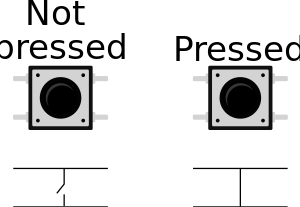Switches and push buttons: Difference between revisions
From wikiluntti
| Line 1: | Line 1: | ||
== Introduction == | == Introduction == | ||
[[File:Switch pull-up-resistor.png|thumb|Simple idea of switch and digital pins]] | |||
The idea is given in the image below. If the switch is open, the pin is connected through the resistor to 5V, but when switch is closed, the pin is grounded to 0V. The resistor is called ''pull-up resistor'', and prevents shorting to ground when the switch is closed. The other method is ''pull-down resistor''. | |||
See more different switches at https://learn.sparkfun.com/tutorials/button-and-switch-basics/all | See more different switches at https://learn.sparkfun.com/tutorials/button-and-switch-basics/all | ||
Revision as of 17:46, 23 July 2023
Introduction

The idea is given in the image below. If the switch is open, the pin is connected through the resistor to 5V, but when switch is closed, the pin is grounded to 0V. The resistor is called pull-up resistor, and prevents shorting to ground when the switch is closed. The other method is pull-down resistor.
See more different switches at https://learn.sparkfun.com/tutorials/button-and-switch-basics/all
Theory A: Simple switch
Theory B: Push Button

A double pole single throw push button micro switch (DPST) is a widely used button. Push button switches are often color coded to indicate their function.
Three methods to wire
- External pullup or pulldown resistor: Use
pinMode( Button_pin, INPUT);in the setup. - Internal resistor (20k-50k Ω): Use
INPUT_PULLUPin setuppinMode( Button_pin, INPUT_PULLUP);. The default value isHIGH(1) and by pressing the button the state goes toLOW. - The bad method: Use
pinMode( Button_pin, INPUT);in the setup without any resistors. The default value will float between 0V and 5V: there is no internal or external
voltage reference for the push button.